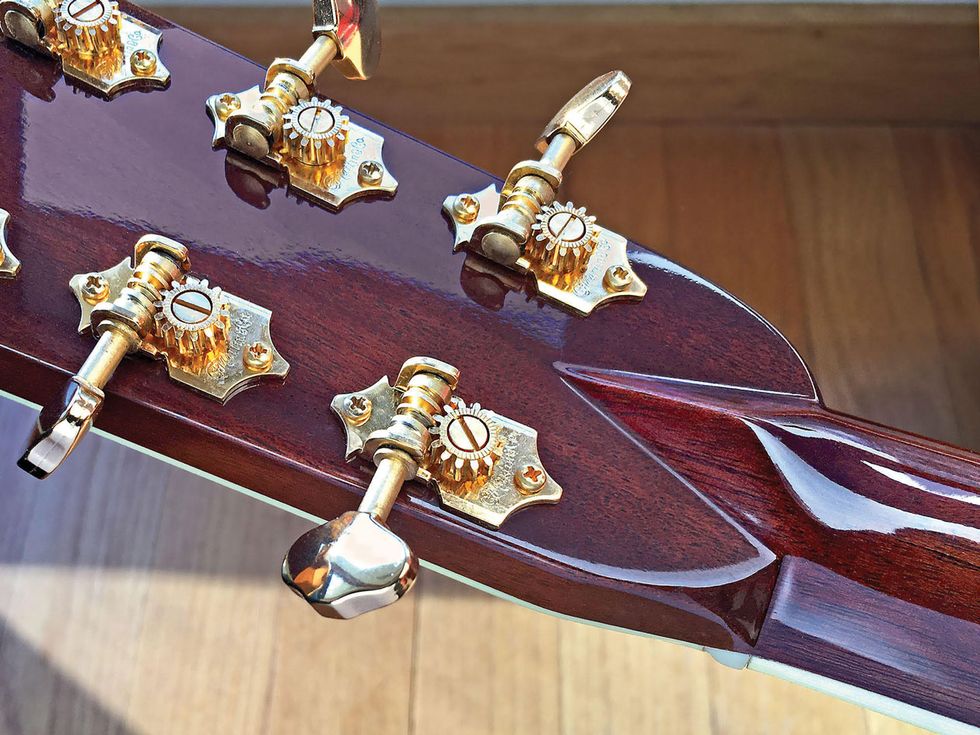When we think of world-champion guitar breakers, Jimi Hendrix and Kurt Cobain come to mind. But even Pete Townshend can’t hold a candle to the infamous creation known as the guitar stand. Quite possibly responsible for the net worth of 10,000 guitar-repair techs, this venerable device has decapitated even more guitars than UPS and United Airlines combined. So, why are guitars so delicate?
Guitarists blame cords. Or drummers. Critics are swift to point to extreme headstock angles or weaker materials, like mahogany. After all, Leo Fender and company put that quarrel to justice long ago by constructing an industrial-grade, fretted Excalibur from rock maple—with no headstock pitch to boot. Known for durability in combat, the bolt-on maple neck stands as de facto judge and jury for less-robust designs. You’d think guitar makers would have gotten the message by now. I can imagine the advertising bullet points:
· Won’t break when you toss it and miss the couch.
· Strong enough to survive a gig bag.
· Stands up to toppling stands.
· What could be better? Airbags?
Pitched (angled) headstocks can be traced back 15 centuries to the medieval oud and its younger cousin the lute. These had long, thin headstocks raked back at nearly 90 degrees—possibly to facilitate easy reach to their tuning pegs. The guitar as we now know it developed from the Spanish guitar (which evolved from the lute), with the headstock pitch reduced to somewhere between 7 and 17 degrees—or, in the case of Fender, zero. Guitar builders of the last four or five centuries have struck a balance between performance and ease of construction, with Fender taking the prize for the latter.
Let’s take a look at how headstocks are constructed. Part of it is tradition born out of functional design. Head pitch keeps strings in the nut by diverting pressure downward on the nut. The slighter the angle, the less pressure, so each designer must choose how steep to go. The downside of more of an angle is friction that can affect string stretching during tuning, bending, and tremolo use. The benefit is greater transmission of vibration at the nut and reduced dissipation of energy to the headstock. Headstock vibration can also be argued, but that discussion is for another day.
The ways to achieve the pitched angle seen on modern guitars fall into two camps. The first is the scarf joint, seen on traditional classical and flamenco guitars. This is simply cutting the flat neck board on an angle and gluing a flat headstock onto that. The pitch is determined by the cut angle. One variation of this type of headstock—sometimes seen on vintage Martins and other acoustics—uses a “bird’s beak” joint to strengthen things up. The side effect is an attractive diamond-shaped affair on the back of the headstock.
The second type is the fully constructed neck, as seen on instruments like Gibson’s and Gretsch’s. This requires a lot more material that’s cut from expensive, thick boards. The result is a nice, clean look, but it unfortunately provides a shortcut for breakage along the grain line, right at the instrument’s most vulnerable point, where neck and head meet. The cutout channel for a head-end truss-rod adjustment weakens this area even more. Some builders attempt to increase strength by creating a bump (called a volute) at the back of the headstock where it meets the neck shaft, but, in reality, the added material falls below the line of most breaks. The truth is that the volute was a manufacturing shortcut, at least until CNC machining made handblending unnecessary.
The Fender example uses string trees on the higher strings to create the downward angle that the zero-pitch headstock does not. This sometimes results in friction-related tuning issues. For the most part, it’s an inexpensive, slightly inelegant solution. In the win column, the zero-pitch head is a three-birds-with-one-stone example of Fender’s design philosophy. The absence of pitch allows a neck to be made of a single, 1"-thick piece of ordinary and plain (aka cheap) maple, while it dispenses with all the pesky woodworking needed to fashion an angled headstock. The bonus is that the grain of the wood is continuous, which helps prevent breakage. Although not as fancy looking as something like a D’Angelico, I still love it, as does most of the guitar universe.
All said, guitars are not alone in their fragility. Classical instruments like the cello and French horn are vulnerable to damage when mishandled. A 4-foot drop wouldn’t do much for an accordion, either. Playing guitar has become a contact sport, which is probably why the question of outsized durability is discussed at all. To me, it seems slightly comical to expect a multi-thousand-dollar guitar to be toddler-proof. My question isn’t why headstocks break. … It’s why we expect them not to.








![Rig Rundown: Russian Circles’ Mike Sullivan [2025]](https://www.premierguitar.com/media-library/youtube.jpg?id=62303631&width=1245&height=700&quality=70&coordinates=0%2C0%2C0%2C0)

















